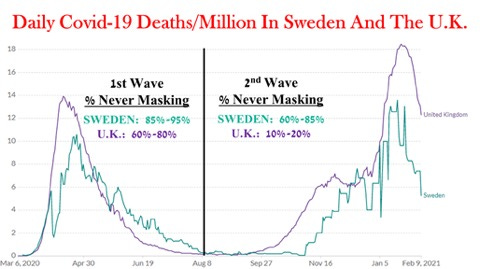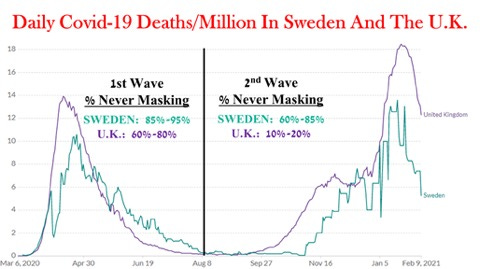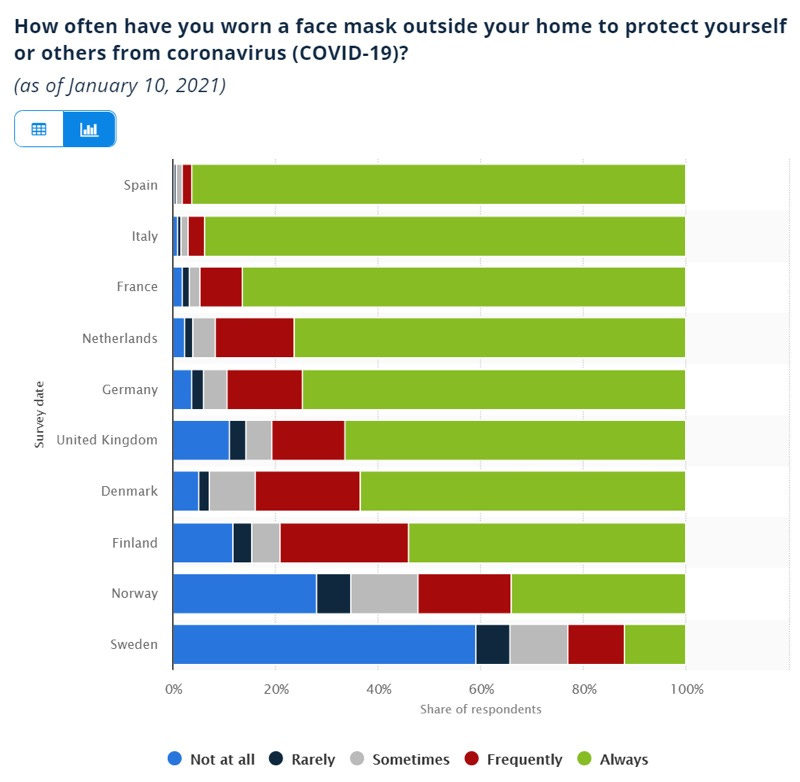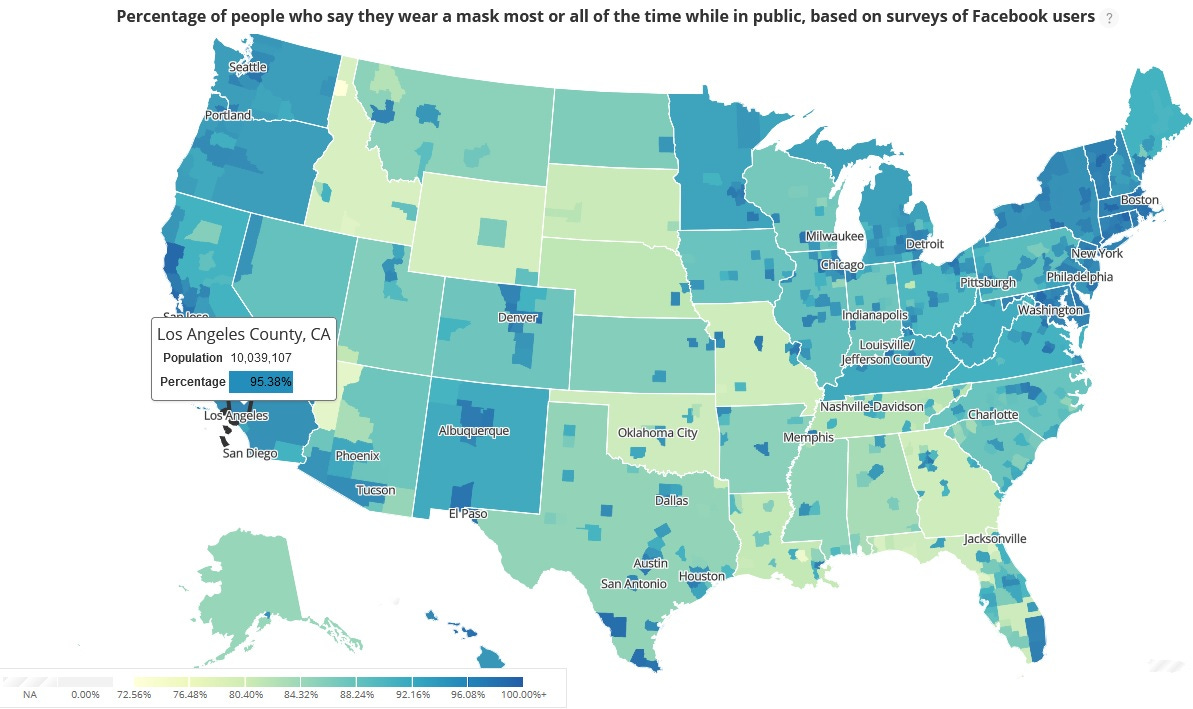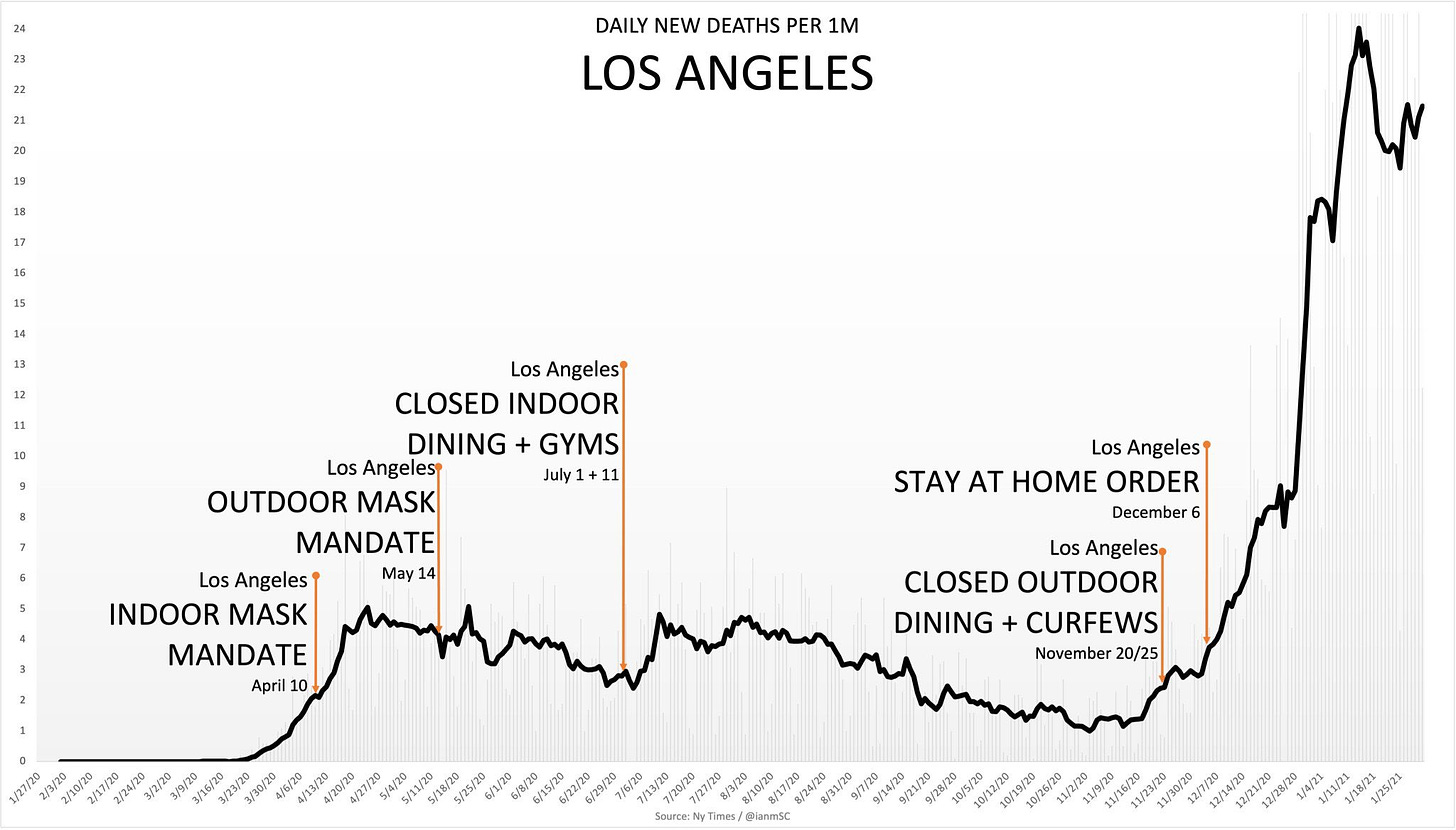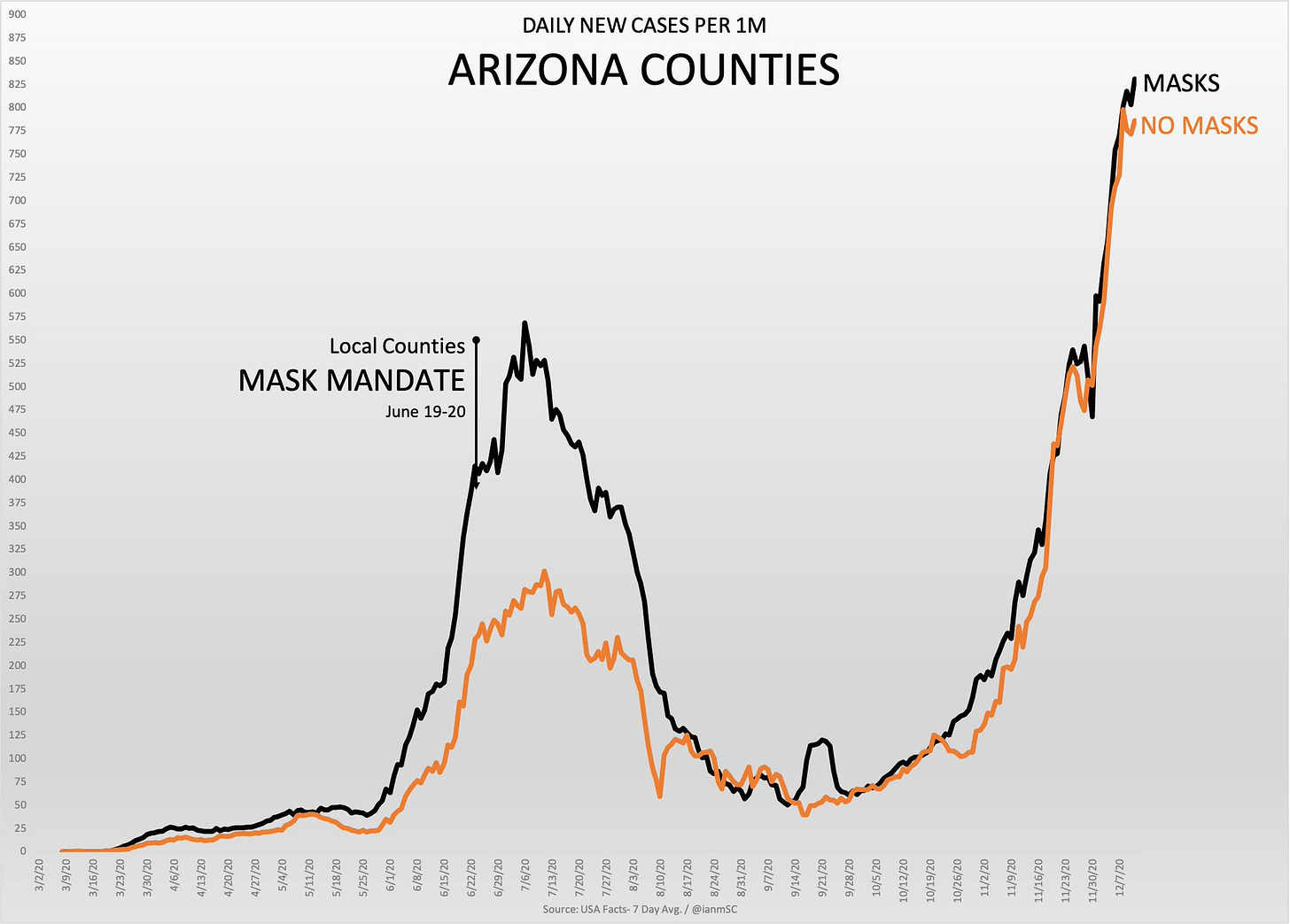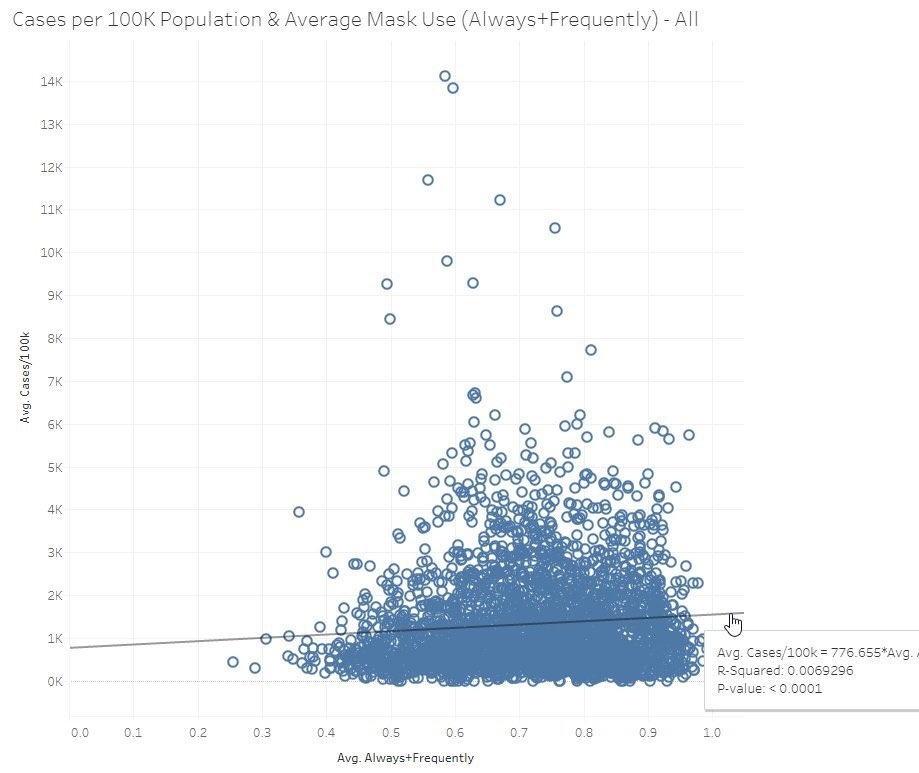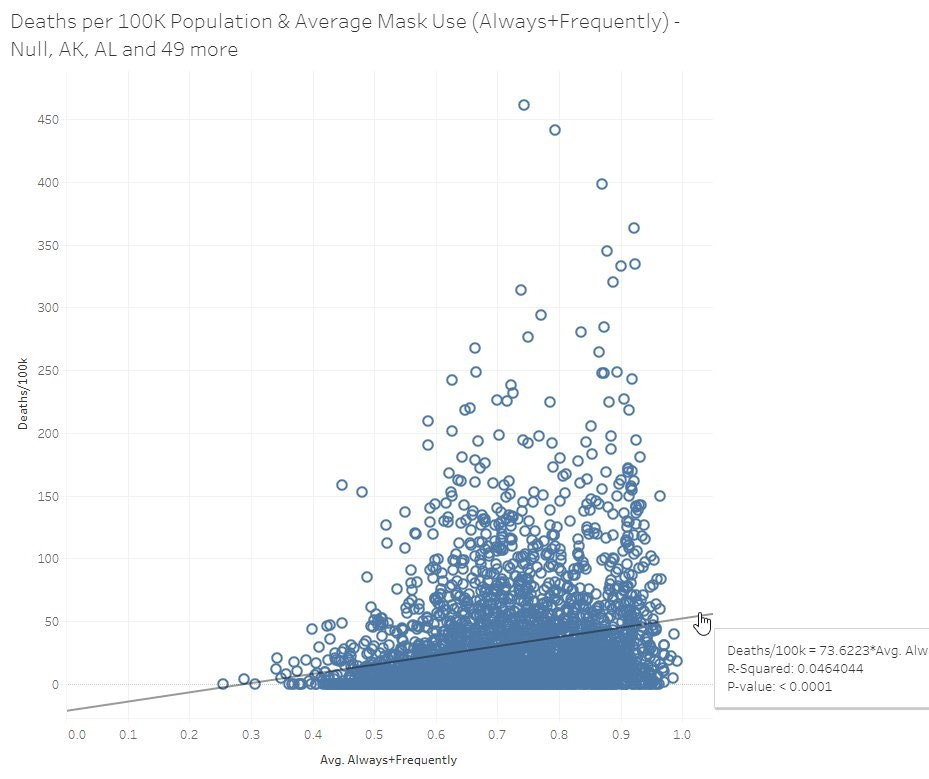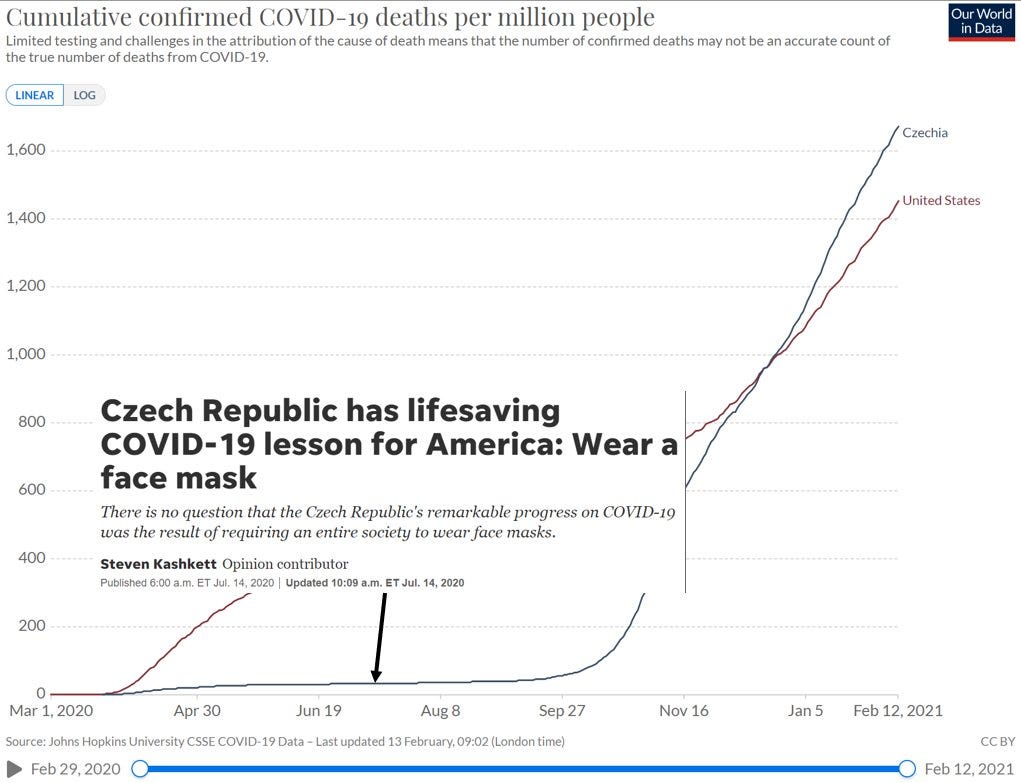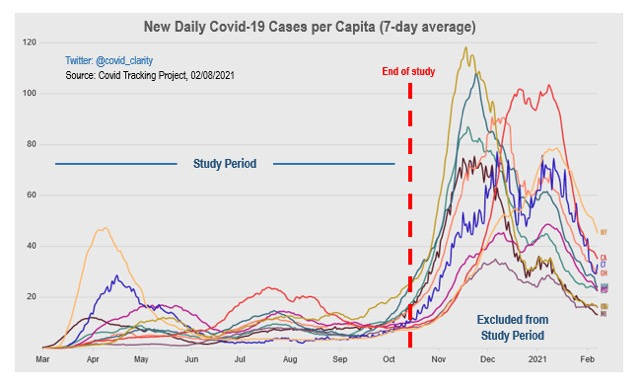If there’s one ever present signifier of this pandemic, it’s masks. In a state like California you can’t avoid them. Yet for all the hype, and all the mandates that followed, their performance has been unimpressive. Here’s my reasoning for why masking this last year hasn’t worked. Let’s start with a graph to explain what I mean when I say masks haven’t worked:
Back in June if you had told me that the UK would get their masking rates into the 80 to 90% range whereas Sweden would still be below 50%, I wouldn’t have predicted this chart. But the data are the data and this is not a unique comparison. Across the country and across the globe places that masked this winter didn’t see better outcomes than places that didn’t. Why?
Let’s backup and start by figuring out what we can all agree that masks can do. I agree with many of the commonly mentioned points explaining how a mask could work. It’s a physical barrier that is going to block a lot of junk that comes out of your mouth. It filters, or at least re-directs the gushing of air from projecting as far in front of you. It stops you from “Speaking Moistly” on people. So I concede that there is plenty of mechanistic reasoning and model based analysis that would lead one to believe that masks could work.
Here’s a good article in Nature that summaries of lot of these concepts and runs through a lot of great experiments that help to show what a mask does: Nature - Face Masks: What the Data Say
The article digs into a bunch of interesting experiments with measuring aerosols expelled from masks and even an experiment with hamsters placed into separate cages with mask material in between. It also discusses how models take the data from these lab experiments and extrapolate the effects they might have in the real world. The article then ends by explaining that some real world data will soon be on the way and that these would inform the scientific debate. Specifically, a randomized controlled trial in Denmark would be published soon proving the protective effects of masks:
Here’s a link to that study: Danish Mask Study
The study randomly split 6,000 adults into a masked and control group. The masked group was given 50 high quality surgical masks (over one for each day of the study) and instructions on how to properly wear them. These folks were set up for success, that’s way better masking than the average American. Regardless the study came back negative, no statistically significant benefits to the mask wearing group. 1.8% of the masking wearing group got infected with Covid, versus 2.1% for the no mask group, both right in line with the general population in Denmark over that time frame. Even more convincing, in a sub-group analysis including only mask group participants who reported wearing face masks “exactly as instructed” the infection rate was 2.0%!
This seems like a shocking results, but it turns out it’s not. Instead, the findings of the Danish Mask study are compatible with the findings from a long history of RCT’s on the efficacy of face masks for prevention of the flu. And these aren’t like random coffee studies, they almost all point the same direction. A July article from the Oxford Centre for Evidence-Base Medicine runs through a number of these trials. Further, the WHO’s 2019 Pandemic Plan (see page 26, btw the entire document is a great read on what a sane pandemic policy would have looked like.) used 10 RCT’s in a meta-analysis to conclude there was no evidence that face masks are effective in reducing transmission which is why they only recommended them for symptomatic individuals. The CDC came to a similar conclusion in their most recent plan in 2017.
Regardless of the model and theories, Randomized Controlled Trials have consistently shown that masks have no effect on protecting the wearer. To add one more nail in the coffin, the CDC’s contact tracing studies (see table on page 4) show that positive contacts wear masks at statistically indistinguishable rates as the control group. If masks had a protective effect, you would expect to see much lower masking rates among positive contacts. Instead you see the same rates showing again that masks don’t provide protection from the virus.
The take away from this is that the virus is finding its way through or around the mask. It means the virus is not spread just from small droplets, but primarily from the microscopic aerosols that are able to pass through the masks and hang in the air for hours. For masks to have any benefit then it would be preventing spread to others, but those same aerosols still make it through the masks the other way. The air filtered through a mask is not moisture free, which implies it’s not virus free. As this paper explains, masks reduce the front flow of air, but also create jets of air out the sides of the mask. As masks become saturated by large respiratory droplets containing virus, air turbulence against the trapped droplets may create aerosols that eventually diffuse around the edges. (I think this it what a lot of the laboratory experiments miss. It’s not enough to test a mask for 30 seconds. Run the experiment for hours and as the mask becomes saturated it becomes useless.) Another study published this year raised the concern that “aerosolized fomites”, cotton or fabric shed from the mask during breathing, are contaminated with virus, and that could contribute to an increase in fine aerosol emission. None of these examples prove the masks are ineffective, just as none of the examples in the Nature article sited above prove they are. However, it is all the more reason to be skeptical of their benefit, and reason to look for stronger evidence like controlled trials.
It’s difficult to run an RCT to measure the effect of masking to protect others. How do you mask one entire city and then not mask another for a control? There are studies in college dormitories that show no statistical difference in flu like illness between masked and unmasked dorms, but proponents of masks would argue that those infections occurred while the students were outside the dorm in an unmasked environment. The Nature article references an ongoing Cluster RCT in Guinea-Bissau in west Africa, but this trial won’t end until next summer, and likely won’t get published until next fall.
Without clear trials to draw a firmer conclusion from, we are stuck with observational studies. And lucky for us, this last year the world has run the largest (and most unethical) observational study on the use of masks! We can look at mask usage around the country and around the world and try to see if there is any signal in the usage of masks compared to the progress of the virus.
The biggest outliers are in the Nordic countries and the results there speak for themselves. They are the same or better than the rest of Europe virus-wise even with dramatically lower mask usage. Reference the Swedish-UK comparison above. You see the same effect in the US. Los Angeles has some of the highest mask compliance in the nation and yet this winter it had some of the highest case and hospitalization rates in the country.
You can look at neighboring states with different masking policies:
You can look at counties within a state with separate policies:
But the signal isn’t there. Granted, policies do not directly imply compliance, but there is a strong correlation, and there are countless other examples like these. And then there’s the example of Florida. No statewide mask mandate, lower masks compliance that most of the country with fewer restrictions than most, and yet they end up below the national average in cases, deaths, etc. Here’s how mask compliance compares to cases and deaths on a county by county level:
Maybe one of the more tragic examples is the Czech Republic. Back in March the Czech Republic was one of the first countries to issue a nationwide mandate. A group put out this very haunting “Message for the World” video imploring other nations to following their example, and cases in the Czech Republic remained very low in the spring (like all eastern Europe, including countries with no mandates…) and Czechia was praised in the media for their strict mask compliance. As cases started to rise in August they re-issued the mandate, but look at what has happened since:
I have a message for the Czech Republic: Masks Don’t Work!
Now are there counter examples? Sure, you can find them, the CDC tried. Last week they released a study which identified 10 states with mask mandates and claimed that the mandates led to a small reduction in Covid hospitalizations, among certain age groups, between March and October. Take a look at the study period versus what happened next?
I can’t believe they would even publish a study like this in February given what occurred between October and the present. Much less a study with such a marginal result which was immediately disproven.
So that is where we stand. Masks don’t move the needle. It seems like they might work but they don’t. Maybe there are some Freak-o-nomic-like effects at play. Where masks would help slow spread a little, but this is counteracted by at-risk individuals feeling a false sense of security because of the mask and then taking additional risks they wouldn’t otherwise take. This article out of the UK questioning why masks haven’t worked ends by stating,
“we should be wary about relying on masks as the mainstay for preventing community transmission. And if we want people to wear masks regularly, we might do better to target higher-risk circumstances for shorter periods. There would be generally places described as “the three C’s” (the UK’s term for Crowded places, Close-contact settings, and Confined Spaces).
I certainly have examples of this in my own experience. I’ve been in waiting rooms surrounded by old-sters who seem in poor health and are certainly at orders of magnitude more risk than I am from the virus. I go inside, make my appointment, and then leave and wait outside in the fresh air. Meanwhile the rest of these folks sit inside with masks on breathing each other’s air. I’m sure everyone would freak out if I took my mask off, but tragically they are at basically the same risk by sitting inside with the mask on.
On a personal note, I live down the road from my 85-year-old grandmother. I visit occasionally, and take out her trash every week, but we always interact outside at a very safe distance. Back during the summer, she had me come inside her home to help set up a streaming service on her TV. I figured if we both had masks on we’d be fine. But learning what I have since I feel this was a significant risk I shouldn’t have taken. Even if the mask helps, if doesn’t help much, and being in the same room as her for an hour or two broke her isolation regardless of whether we had masks on. Had I been an asymptomatic carrier at the time, I’d feel immensely stupid trusting her life to a sheet of cotton.
I believe our public messaging is seriously flawed, by placing so much emphasis on masking that it leads to greater risk taking by the vulnerable. Basically anything you aren’t willing to do with a mask off you shouldn’t be doing with a mask on, but that’s not how people treat the mask. Instead it’s a magical talisman that keeps the virus at bay, and if only those last remaining few would just wear the damn mask this thing would be over! If only…
Instead we just keeping getting more mandates. If cases go up, “you’re not masking enough, mask harder!” If cases go down, “it’s because masks work, keep masking!” Meanwhile all the real world data, all the real world evidence points to the fact that masks have little to no effect on the course of this virus.
If something is not testable by data and evidence, it’s purpose is not science! I feel that’s where we are with masking. (That’s certainly where we are with schools…) It’s a great theory, and there are a lot of bench experiments you can run to make it appear that masking will work, but time and time again we tested it in the real world, masking has not meaningfully slowed the spread of this virus to a level that we can detect. Discussing masks now reminds me a lot of discussing the Stimulus Bill back in 2010. “It didn’t work,” I’d say. But no, the argument was if it hadn’t been for the Stimulus the recession would have been Even Worse! Or maybe a better analogy is Welfare. Intuitively, it makes a certain amount of common sense that if you give the least fortunate among us monetary relief they should be better off, but just like with masks it turns out the world is much more complicated than a simple model in a lab, and it ends up not working in the real world. Or maybe it’s more like Socialism, “Real Masking Has Never Been Tried!!” I feel that’s where we are now with double masking…
Regardless, wear a mask if you prefer, but it’s long past time for government mandates to end. The data are in, you can find comprehensive a list at this link. Masks don’t work!
Anyway, 0 and 2…

